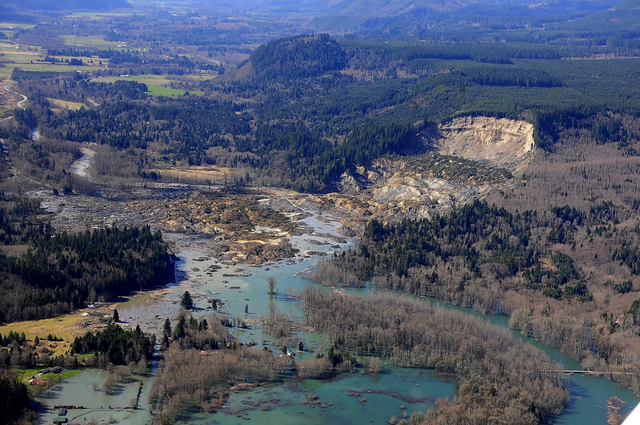
SEATTLE – Receding floodwaters at the site of the deadly mudslide at Oso were helping in the search for human remains by exposing more sites that can be examined, officials said Tuesday.
Officials also said the confirmed death toll from the March 22 slide has risen from 27 to 28. Twenty-two of those victims have been identified.
The latest names added to the list were 65-year-old Thom E. Satterlee, 60-year-old Lon E. Slauson and 23-year-old Adam Farnes. All have blunt force injuries listed as the cause of death in the March 22 slide, the medical examiner’s office said.
Twenty-two people remain on the missing list, although Satterlee and Slauson were among those names.
Search effort division supervisor Steve Harris said at a news briefing that more human remains were found Tuesday morning at least in part because of the receding water.
The massive mudslide dammed up the North Fork of the Stillaguamish River, causing water to pool. Heavy rain last week added to the flooding.
“The water’s been receding and exposing new areas and helping tremendously in search efforts,” Harris said.
Harris also said based on what he’s seen, an approximately 3-mile stretch of the main highway through Oso was entirely wiped out in the slide. The wall of mud, trees and debris hit State Route 530 just east of the rural mountainside community.
“There’s no highway left there,” Harris said. “There’s a lot of work to be done there before the highway can be reopened.”
The two-lane road is a regular route for people from nearby mountain towns and for some Seattle-area residents who travel to the North Cascades Mountains for recreation.
Snohomish County and state transportation officials last week opened the Mountain Loop Highway, an alternate route between the towns of Darrington to Granite Falls that usually is closed during the winter by snow.
In an additional request for federal assistance Tuesday, Gov. Jay Inslee said the mudslide and flooding has caused an estimated $32.1 million in damage, which includes $10 million in emergency measures such as helicopter rescue, shelter operations and recovery efforts.
The remaining $22 million is the state’s best guess of what it will cost to remove all the debris, according to Karina Shagren, spokeswoman for the Washington state military department.
The latest figures are in addition to the estimated $10 million in damage to homes and other belongings destroyed in the slide area. That number was included in a Monday letter seeking a federal major-disaster declaration.
“I expect the President will respond to my initial request quickly,” Inslee said in a statement. “In the meantime we will continue our efforts to secure additional federal assistance.”